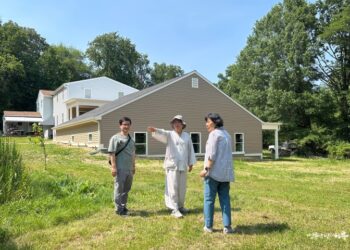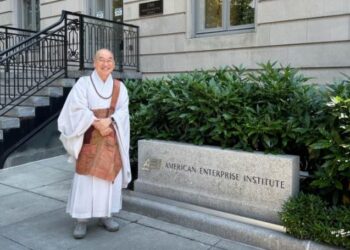Jun 3, 2025 – Visit to Silsangsa Temple, 161st Anniversary Memorial Service for Master Yongseong’s Birth
Hello. Today is the day of the memorial service commemorating the 161st anniversary of Master Yongseong’s birth at Jangsu Jukrimjeongsa Temple. Master Yongseong was an independence activist and a great reviver of modern Korean Buddhism. Sunim departed from Dubuk Retreat Center at 5 a.m. to attend the memorial service.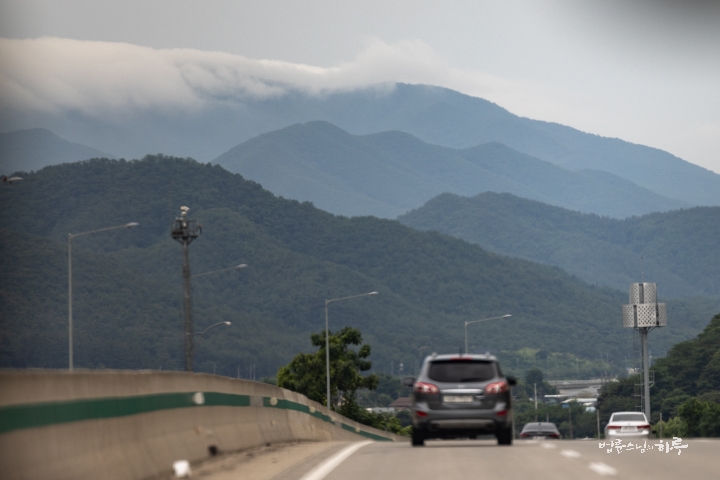
On the way to Jangsu Jukrimjeongsa Temple, Sunim first visited Silsangsa Temple. He went to visit Venerable Dobup, the spiritual leader of Silsangsa Temple, who was reported to be in poor health.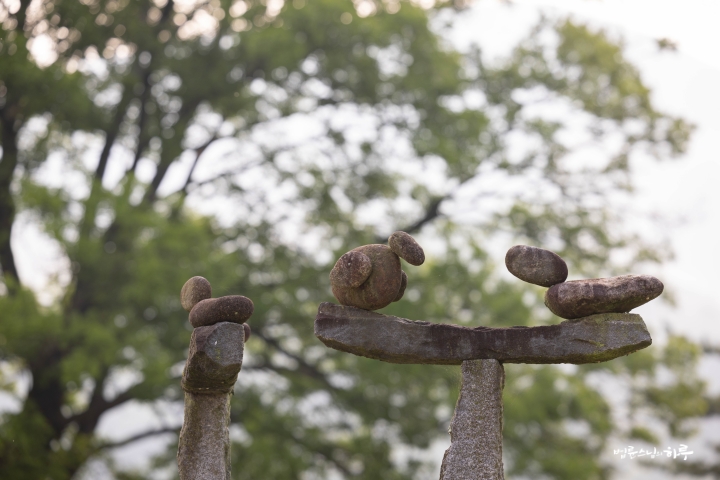
After driving on the highway for two hours, Sunim arrived at Silsangsa Temple after 7 a.m. As Sunim entered the temple grounds, Venerable Dobup warmly welcomed him.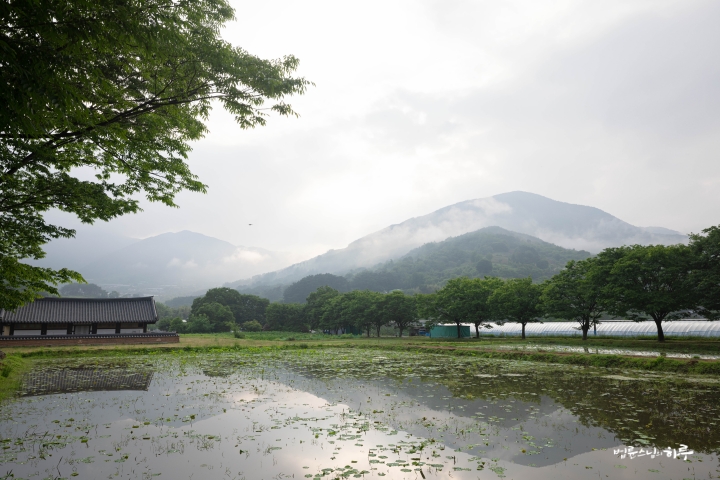
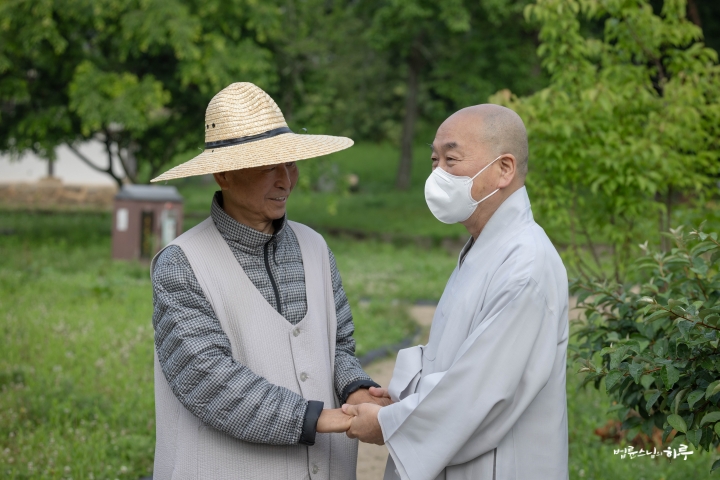
“How is your health?”
“What health? I’m getting by just fine.”
“Venerable Sugyeong told me your health wasn’t good, so I stopped by on my way to Jukrimjeongsa Temple.”
“That’s right. Venerable Sugyeong visited recently. I’m fine.”
After exchanging greetings, Sunim toured the temple grounds with Venerable Dobup to discuss how to proceed with the event, as the INEB Jungto Society delegation is scheduled to visit Silsangsa Temple at the end of June. Every corner was neatly and well-maintained.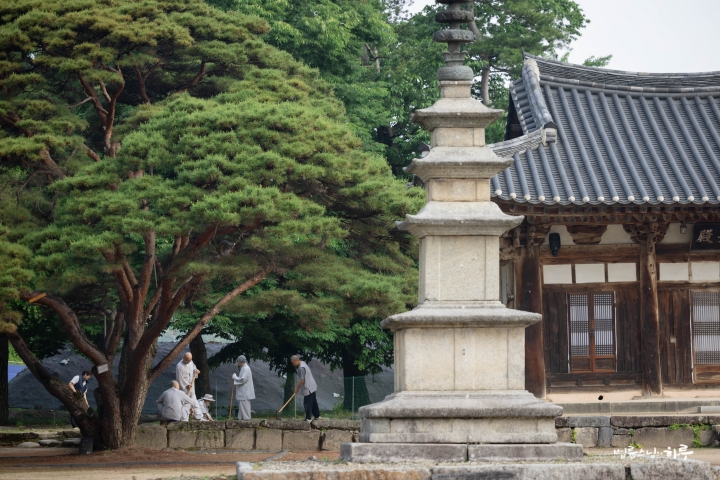
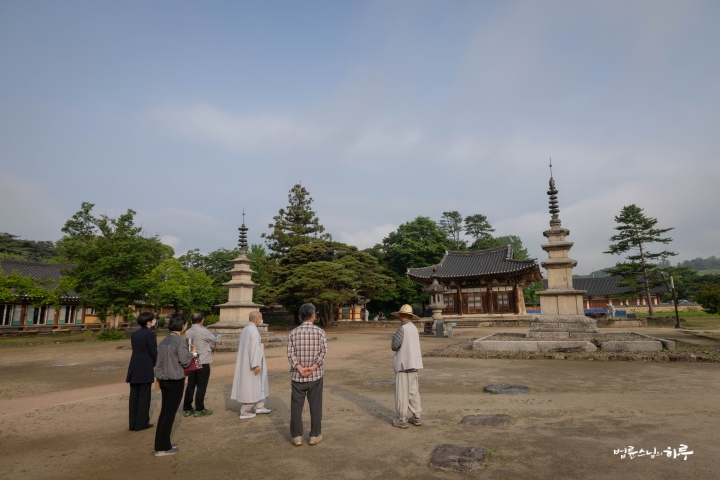
After having breakfast together in the Silsangsa Temple dining hall, Sunim shared tea and conversation with Venerable Dobup before leaving Silsangsa Temple.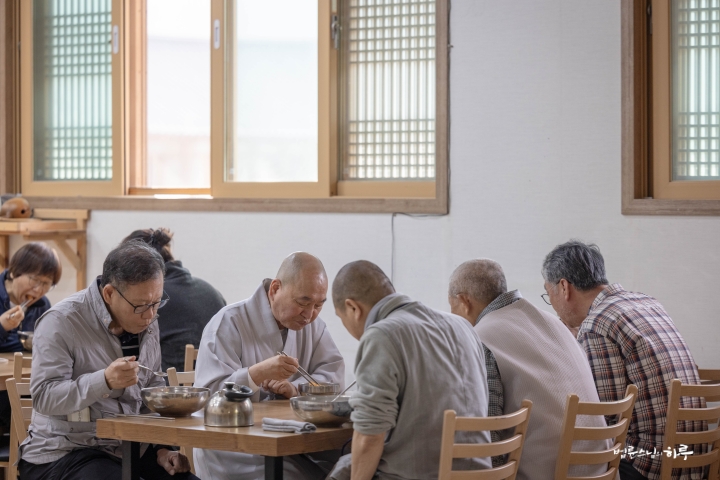
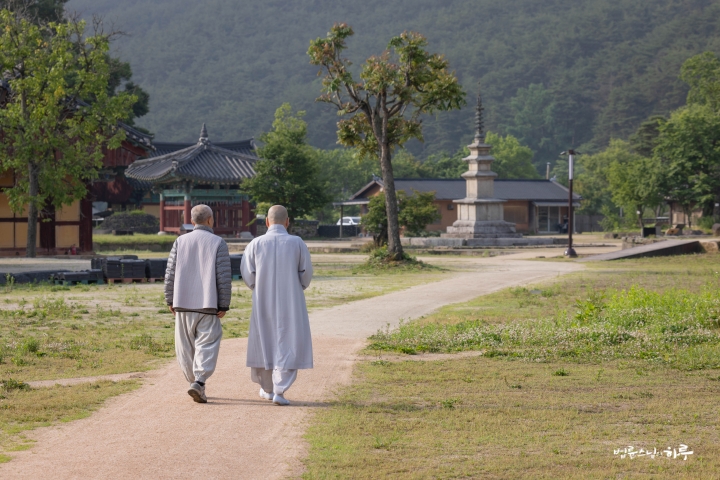
After another 30-minute drive, Sunim arrived at Jangsu Jukrimjeongsa Temple at 9 a.m. Before beginning the memorial service, a tea ceremony was held to honor the successive lineage masters.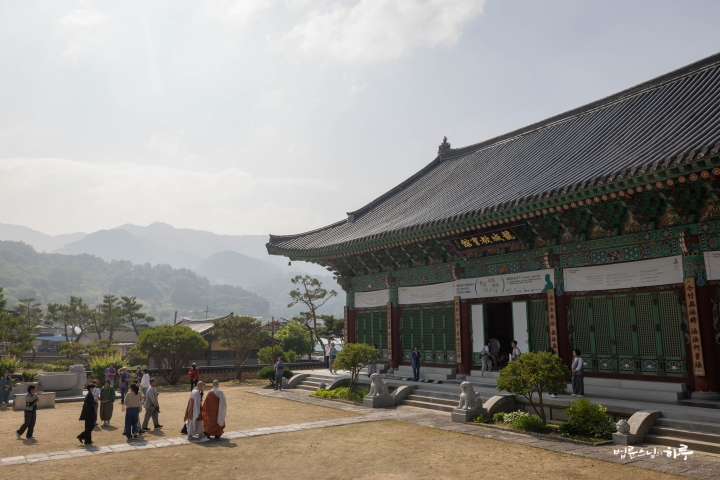
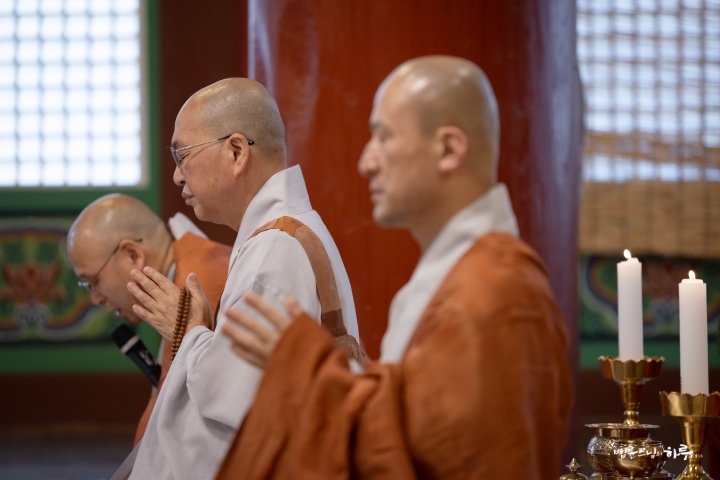
After completing the tea ceremony and paying respects at the main hall, Sunim toured the construction site of the Yongseong Memorial Hall being built in Mulbit Park.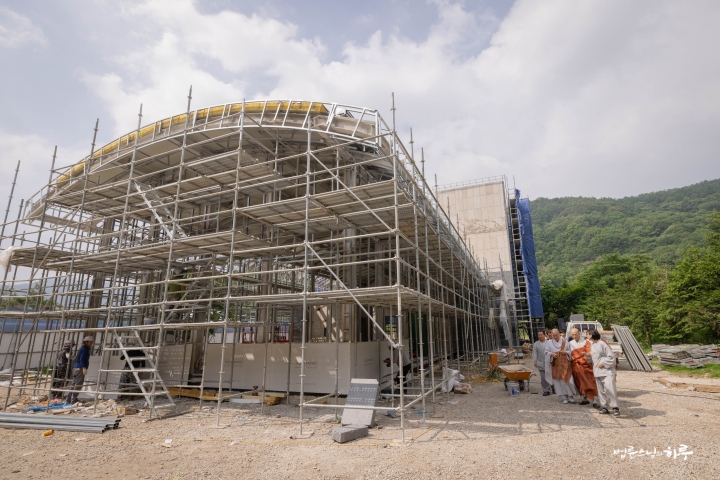
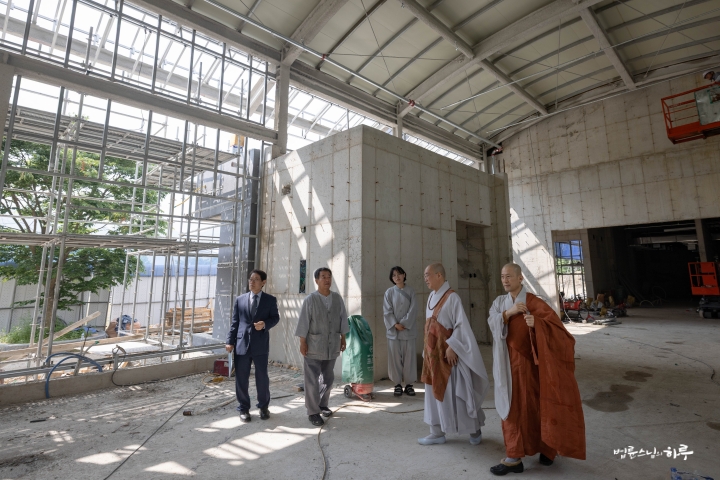
The structural work forming the building’s framework—foundation, columns, beams, floors, walls, stairs, and roof—has been completed. Construction will continue for another six months, with the completion ceremony scheduled for the end of the year. After encouraging the Jungto Society construction team and the construction company staff working on site, Sunim headed to the Yongseong Education Center for the memorial service.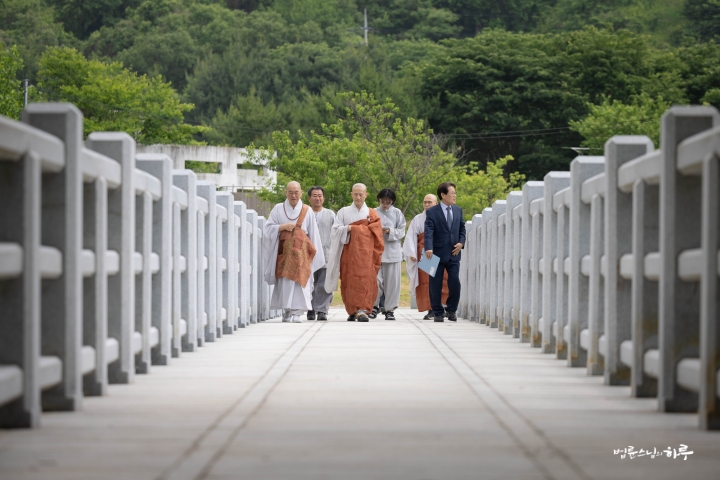
The memorial service began at exactly 10 a.m. with about 400 Jungto Society members in attendance from across the country, including the Daejeon-Chungcheong Division, Gyeongnam Division, Busan-Ulsan Division, Gwangju-Jeolla Division, and the Happiness Movement Headquarters.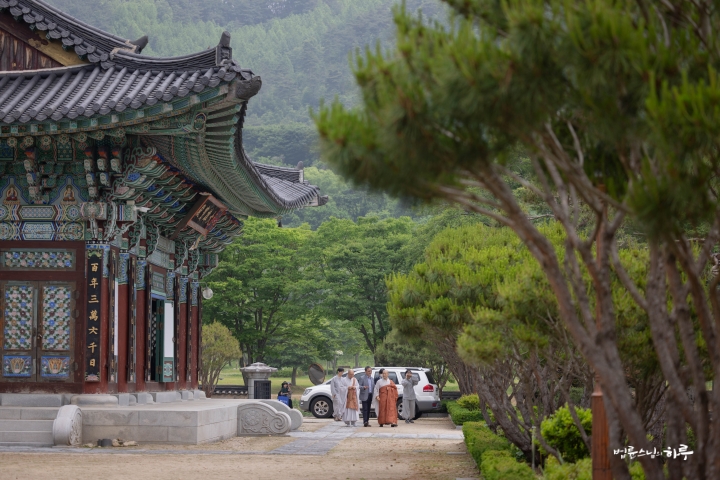
After reciting the Three Refuges and the Heart Sutra, the ceremony included saluting the national flag, singing the national anthem, and observing a moment of silence for fallen patriots. Jeon Hae-jong, President of Jungto Society, then read Master Yongseong’s biography.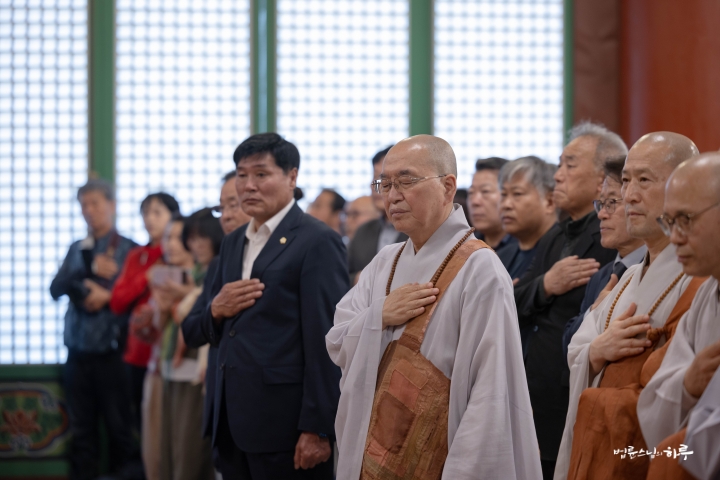
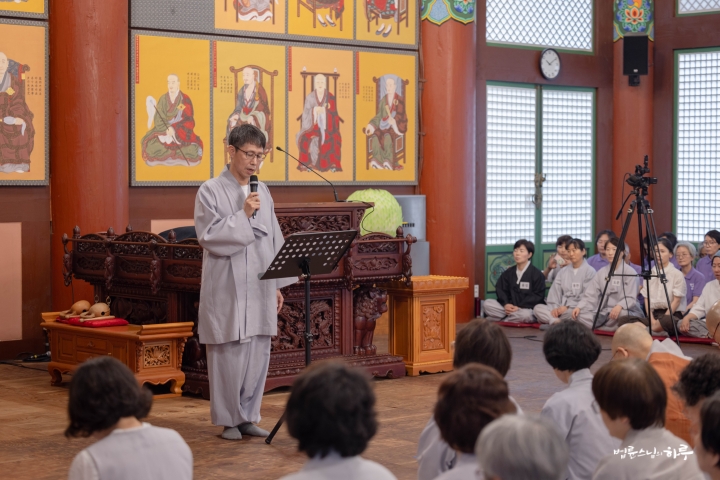
Distinguished guests were then introduced. Local community leaders graced the occasion, including representatives from Jangsu County Council, Jangsu Cultural Center, Jangsu County Office of Education, Master Baek Yongseong Memorial Foundation, Beonam Township Office, Jangsu Agricultural Cooperative, Beonam Township Residents’ Autonomy Committee, and the Village Chiefs’ Association. Among them, Councilman Lee Jong-seop from Jangsu County Council delivered congratulatory remarks.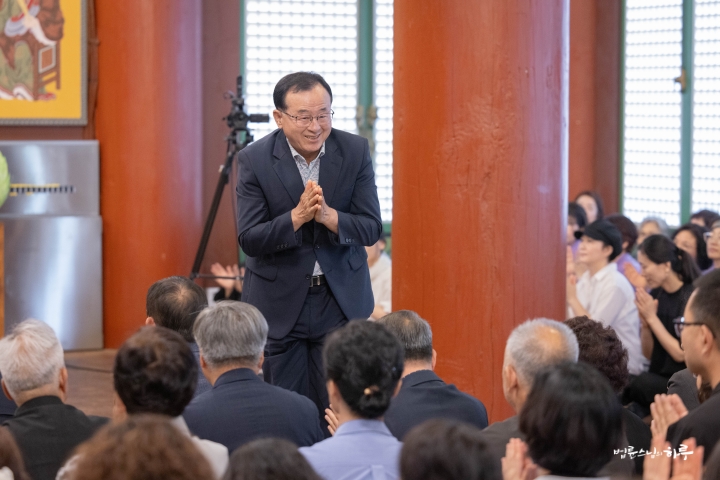
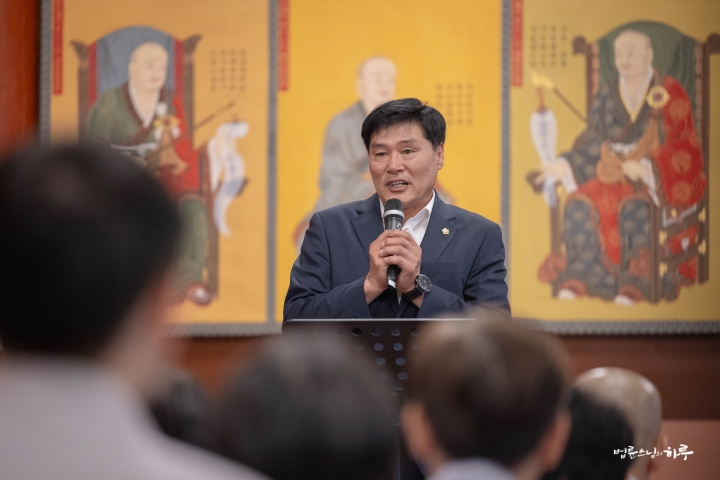
Next, members of the Daejeon-Chungcheong Division presented a commemorative performance in honor of Master Yongseong’s birthday. The epic story unfolded in a 10-minute play spanning five acts, from Master Yongseong’s birth through his path as an independence activist to his final teachings and passing into nirvana.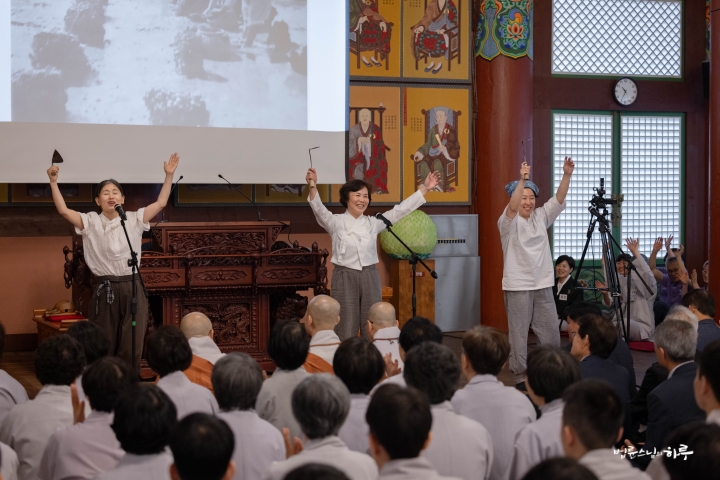
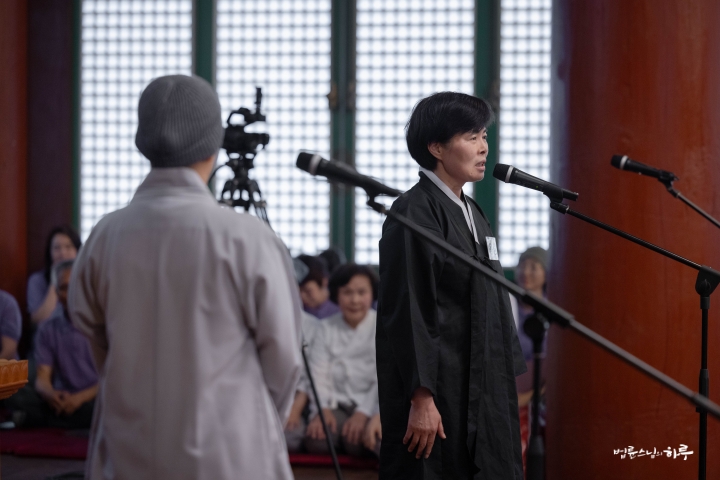
“As Master Yongseong said, the Republic of Korea will now open a brilliant path and take a new road that no one has traveled before. That path is right before our eyes. Now we will do it!”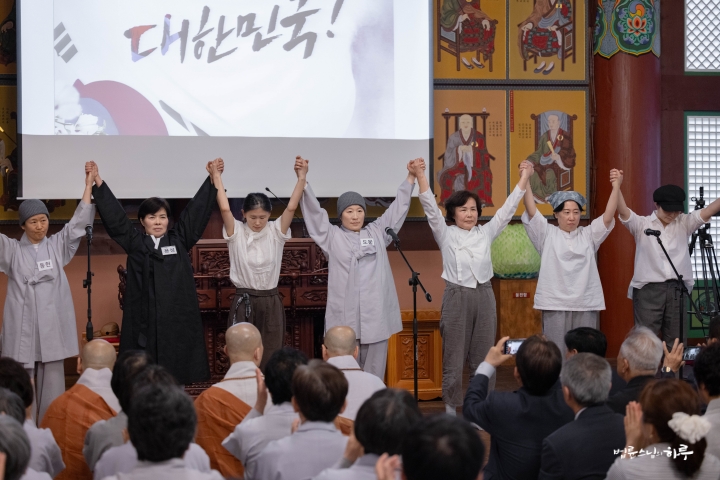
Everyone gave enthusiastic applause to the declaration that “Now we will do it!”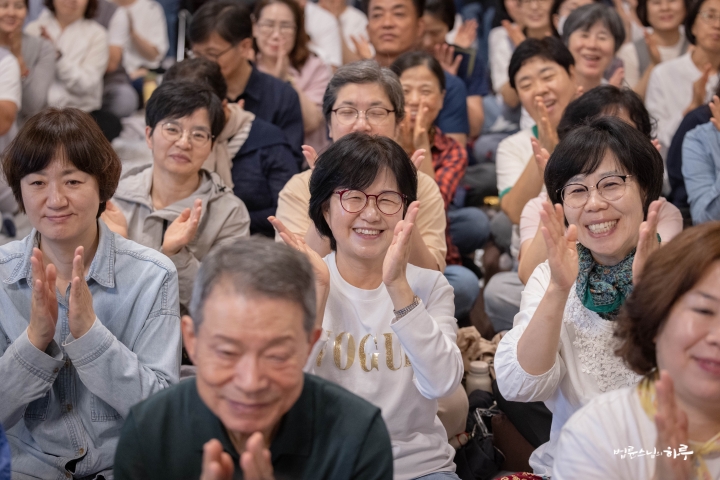
Everyone then sang “Song of the Whole Nation” together. This song was written by Master Yongseong and arranged by Venerable Bulshim Domun. Led by the Jukrimjeongsa Temple guide team, everyone sang together with vigor.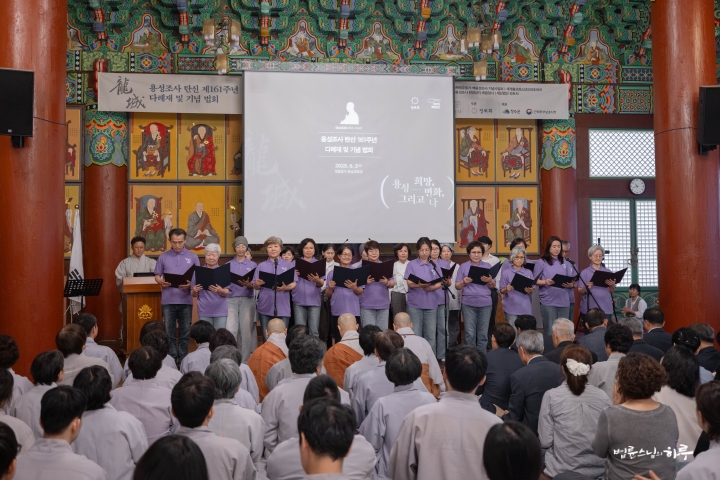
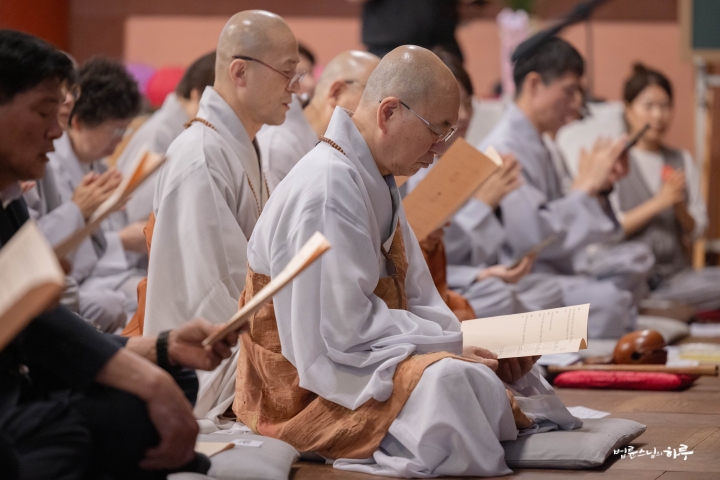
Next, Venerable Pomnyun Sunim gave a commemorative Dharma talk on the theme “Yongseong, Hope, Change, and I.”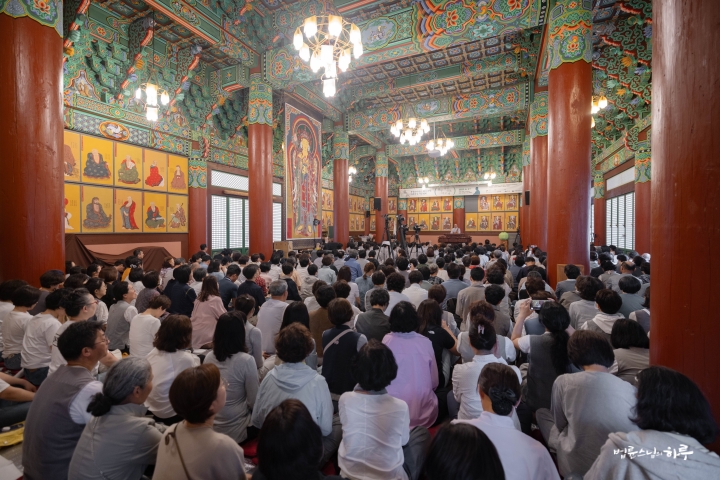
“Today marks the meaningful 161st anniversary of the birth of Master Yongseong Jinjong, the 68th patriarch in the lineage entrusted by Shakyamuni Buddha. Last year, to commemorate the 160th anniversary of his birth, we held the ‘Ten Thousand People Dharma Assembly’ at Mulbit Park in front of Jukrimjeongsa Temple, where 10,000 people gathered to pray for peace on the Korean Peninsula, national unity in the Republic of Korea, and the nation’s sustainable development. With Venerable Bulshim Domun as the certifying Dharma master, many distinguished guests, social leaders, elders, and politicians joined 10,000 Jungto Society members in earnest prayer with one heart. Perhaps as a result, looking back, last year tensions on the Korean Peninsula had escalated to the point where the possibility of war was a concern. However, miraculously, starting from the end of the year, the U.S. president changed, and in Korea, the attempt to impose martial law failed, among other significant changes that occurred in succession. The war crisis on the Korean Peninsula has been significantly alleviated, and the situation is facing a new phase.
If a new government is soon inaugurated and the U.S. president moves to improve North Korea-U.S. relations, we may open the possibility of ending the armistice system that has lasted for 72 years and moving toward a peace system without war ever again. Therefore, at this point, we should pray and practice even more earnestly for peace not only for our nation and people but also for East Asia and the world.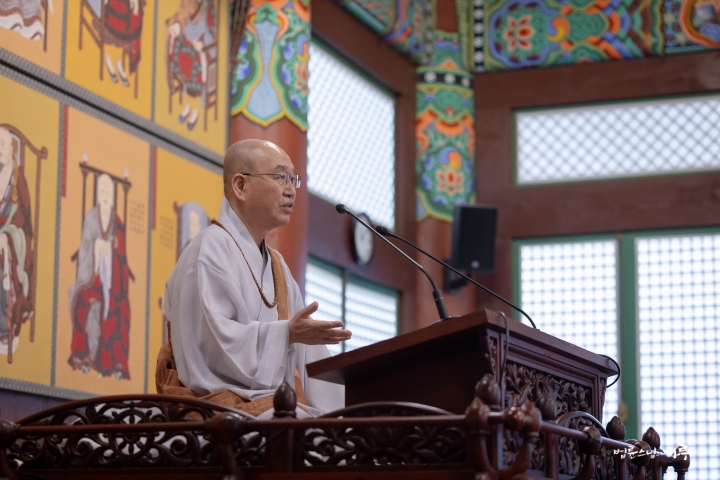
Master Yongseong Who Awakened Buddhism and Korea: The Path of Innovation and Independence
Today, as we commemorate the 161st anniversary of Master Yongseong’s birth, looking back on his life reveals that he walked a path different from most Korean monks. Korean monks primarily focus on personal practice or praying for the blessings of sentient beings. Since they have left the secular world, there was a strong notion that involvement in worldly affairs was not the proper role of a monk. Additionally, under the perception that Buddhist scriptures should be read in their original Chinese text to be authentic, the tradition of studying and chanting Buddhist scriptures in Chinese continues to this day. However, Master Yongseong brought change and innovation to these long-held notions and traditions of Buddhism, pursuing the intellectualization, popularization, and practical application of Buddhism in daily life. He translated Chinese scriptures into Korean so that anyone could easily read and understand them. At a time when there was not a single temple within the four gates of Seoul, he purchased a private home and established a temple called ‘Daegaksa,’ opening a propagation center where the public could easily come and go. By holding Dharma assemblies for children and operating meditation centers for women, he opened a path where Buddhism was not the exclusive domain of monks, but where anyone with the will could learn the Buddha’s teachings. He also composed Buddhist hymns and introduced the reed organ, in keeping with the times, and took the lead in changing complex and difficult traditional Buddhist rituals into Korean that anyone could understand. While such practices are now commonplace, attempting such changes a hundred years ago was by no means an easy task.
Furthermore, Master Yongseong devoted himself wholeheartedly to the most sensitive issue of the time: ‘national independence.’ Resisting Japanese imperial colonial rule and pursuing independence meant risking one’s life. Even during such harsh times, he continued his activities tirelessly, dreaming of the nation’s independence. In the process, he also suffered imprisonment. 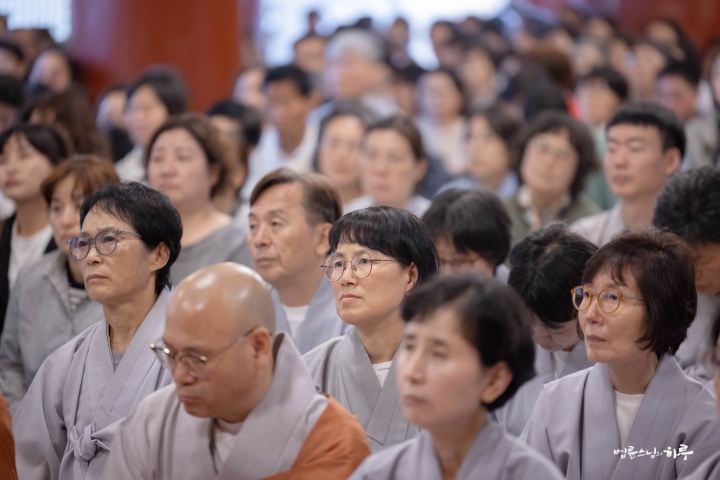
During the five hundred years of the Joseon Dynasty, Buddhism suffered severe oppression from the Confucian-centered society. It wasn’t until the Gabo Reform of 1894 that Buddhism began to gradually free itself from government suppression. At the same time, as Japanese Buddhism flooded into Korea, the domestic Buddhist community gained more freedom to operate but also experienced great confusion. Many monks went to Japan to study Buddhism and returned. While the Japanese Government-General colonized Joseon, they treated monks relatively well, unlike Confucian scholars or government officials. As a result, Buddhism at that time, far from resisting Japanese colonial rule, showed gratitude and even displayed pro-Japanese attitudes. In this era, it was highly exceptional for a Joseon monk to stand against Japanese imperialism, reject Japanese Buddhism, and attempt to establish the unique identity of Korean Buddhism. Master Yongseong became a monk during the dark period when Buddhism had been oppressed by the Joseon Dynasty for five hundred years and monks were treated as the lowest class of society. For someone of such status to call for national independence meant being prepared to face death. Nevertheless, Sunim walked this path, innovating Buddhism while lighting the lamp of hope for independence for our nation.
The Hidden Cornerstone of the March 1st Movement: Master Yongseong Who Prepared the Shanghai Provisional Government
Master Yongseong began to actively engage in worldly affairs around the time of the Eulsa Treaty in 1905. While we commonly believe that Korea lost its sovereignty with the Japan-Korea Annexation in 1910, in reality, the country had already lost its sovereignty when diplomatic rights were stripped away by the Eulsa Treaty in 1905. The following year, in 1906, Master Yongseong went to Haeinsa Temple to work on the Tripitaka project and raised some funds. With support from benefactors including layman Im Dong-su, he traveled to China in 1907 to prepare for establishing a government in exile. At that time, he had already laid the financial foundation for the provisional government in Shanghai. However, when Joseon was forcibly annexed in 1910, we could not immediately establish a government in exile. Historically, when a country is conquered, it is common for some royalty to go abroad and establish a government in exile. Emperor Gojong also made various attempts, including sending secret envoys to The Hague in 1907, but ultimately achieved no results. 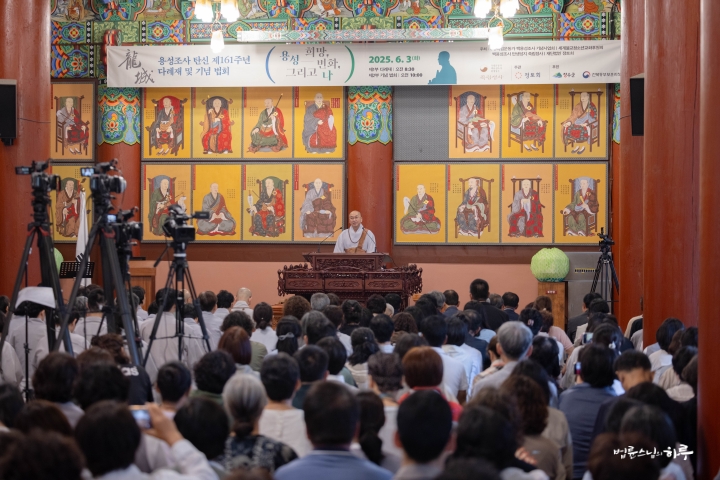
Eventually, Joseon lost its sovereignty in 1910, and nine years later in 1919, the March 1st Independence Movement erupted nationwide. In April of that year, the Provisional Government of the Republic of Korea was established in Shanghai. The Declaration of Independence was made on March 1st, but how could a provisional government be born in just one month? This was possible because Master Yongseong had laid the financial foundation in Shanghai much earlier, secured buildings, and made meticulous preparations. In this way, Master Yongseong was the behind-the-scenes pillar of the March 1st Movement and the force behind the establishment of the Shanghai Provisional Government. However, as a practitioner following Buddhist teachings, Sunim worked quietly from behind, never revealing himself publicly, maintaining a supportive stance.
The History of the Independence Movement That Could Not Be Recorded
Master Yongseong continued to steadily support the families and wounded of independence fighters in the Manchuria region. He also led many young people to join the independence movement, including sending Yun Bong-gil to the Shanghai Provisional Government. While numerous hidden stories are passed down, no evidence could be left behind due to the severe oppression by the Japanese. The fact that there are almost no revealed records actually demonstrates how perfect and meticulous Sunim’s activities were. Having much evidence might actually mean that movements were carried out carelessly. Since we often lack records to prove the reality of the independence movement, we frequently evaluate the contributions of independence fighters based mainly on Japanese trial records or investigation documents. The reality is that if one’s name appears in records created by Japanese imperialism to punish independence fighters, they become recognized as great independence fighters, but without records, they cannot be recognized as such. Even those who did nothing but have records are recognized as independence fighters, while those who devoted themselves fiercely but left no evidence are treated as if they did nothing. Master Yongseong also always moved thoroughly from behind the scenes, making it difficult to properly understand his contributions. 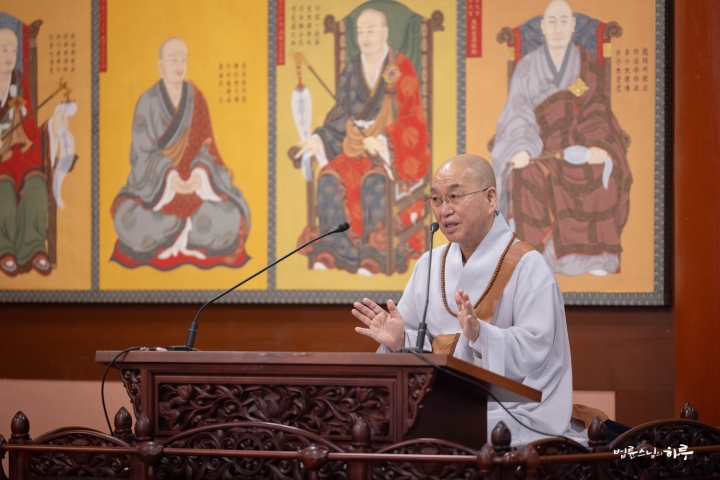
During the March 1st Independence Movement, when Han Yong-un and the other 33 signatories were preparing the Declaration of Independence, a similar situation occurred. Out of concern that “if Master Yongseong is also arrested, who will take responsibility afterward?” they had Master Yongseong step back and put others forward. As a result, historical records do not show Master Yongseong as having directly signed the declaration. At that time, when Han Yong-un asked to borrow his seal, Master Yongseong lent it to him. Even on the day the Declaration of Independence was announced, they concealed Master Yongseong’s involvement by saying things like “I went because I heard people were gathering, and that’s what happened.” Consequently, Master Yongseong appears in the records as someone who merely lent his seal to the Declaration of Independence without playing any real role. Anyone who has experienced the democratization movement would understand this. There are always those who appear at the forefront and those who play substantial roles behind the scenes. There were people who devoted everything yet couldn’t even leave records during their time because it was too dangerous. But as time passes, people demand records as proof of their contributions, and whether someone is recognized as an independence activist depends on the existence of such records.
In situations where no records remain, what becomes important is “testimony.” The Venerable Bulsim Domun preserves numerous valuable oral testimonies that we should cherish. His family has maintained vivid memories of Master Yongseong’s activities, as they supported him across four generations – from his great-grandfather, grandfather, father, to the Venerable himself. While Master Yongseong was the visible figure, behind him was Sa-eun Im Dong-su, a comrade, friend, and patron who shared his vision and enabled him to accomplish such work. He was the Venerable Bulsim Domun’s great-grandfather. As a wealthy landowner possessing ten thousand seok (approximately 1.8 million liters) of rice fields, he willingly contributed nearly all his wealth — including his own and that of his relatives, totaling thirty thousand seok (about 5.4 million liters) — to the cause of national independence. These wealthy landowners were the affluent families of the Namwon, Jangsu, and Unbong regions. They made brilliant contributions from the Donghak Revolution through the independence movement to the establishment of today’s Republic of Korea. Now is the time to properly re-examine and evaluate their contributions. 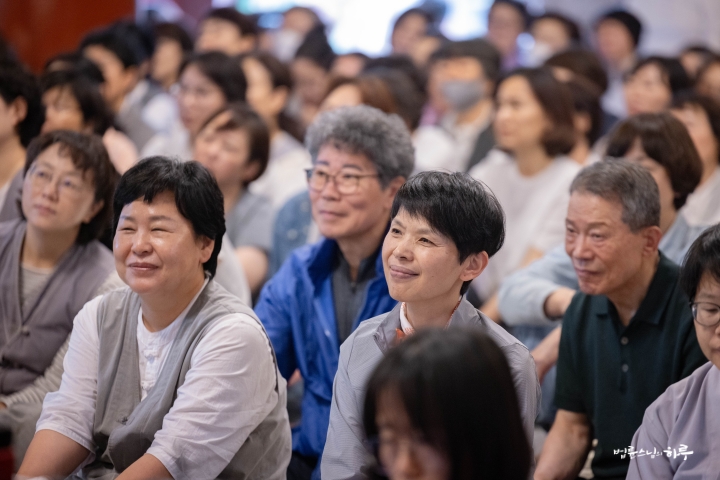
Master Yongseong cannot be said to have received enthusiastic support from the general public at that time. However, he was active with the support of social leaders, especially the wealthy class and the royal family. Among them, the support from Queen Sunjong was particularly special. This fact shows that even among the social leaders of the late Joseon Dynasty, there were some who worked hard for the country’s independence. Therefore, although Joseon was ruined by the social leaders of that time, we should not say that all of them were bad. The wealth of the millionaires centered around Layman Im Dong-su and the assets from the royal family were secretly used for Korea’s independence through Master Yongseong.
The First Step of 800 Years of the Great Korean Nation, the Just Country We Will Create
Today, on the 161st anniversary of Master Yongseong’s birth, we once again reflect on his life and teachings. Master Yongseong said that a new path for the Republic of Korea would open from 2025. Although he left a prophecy that the great fortune of 800 years of the Great Korean Nation would begin, those words felt overwhelming to us living today. Until last year, we worried that rather than opening, the great fortune might be closing. However, now with the launch of a new government, there is hope that a new path might open. Rather than talking about gloomy stories, it is time to move forward progressively with even small hopes. It is time to end the state of war that has not been concluded for the past 75 years, establish a peace system on the Korean Peninsula, and realize mutual cooperation between the South and North and national unity. I believe that creating a country where the people are the masters, a just and righteous Republic of Korea together, is the way to realize Master Yongseong’s teachings.” 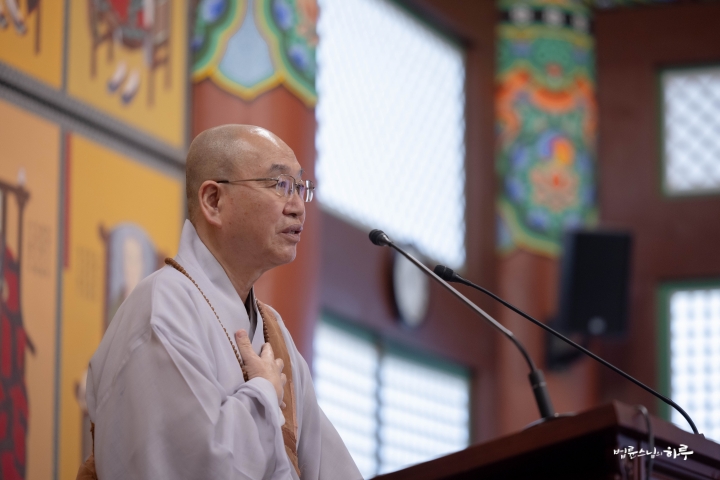
The commemorative ceremony concluded with the audience taking Sunim’s Dharma talk to heart and praying for peace and unification on the Korean Peninsula.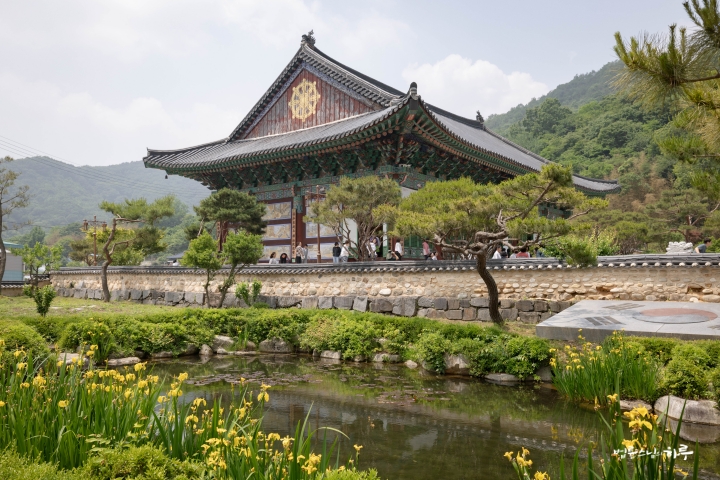
After the distinguished guests left and the venue was briefly reorganized, a Dharma Q&A session began immediately at 12 PM. First, a commemorative photo was taken with the approximately 400 people who attended in person.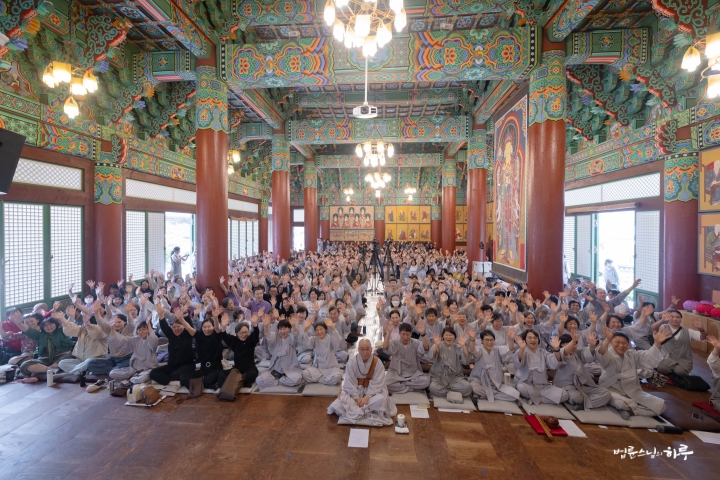
As the opening performance, Mr. Lee Seon-ho sang cheerful songs with her rich voice.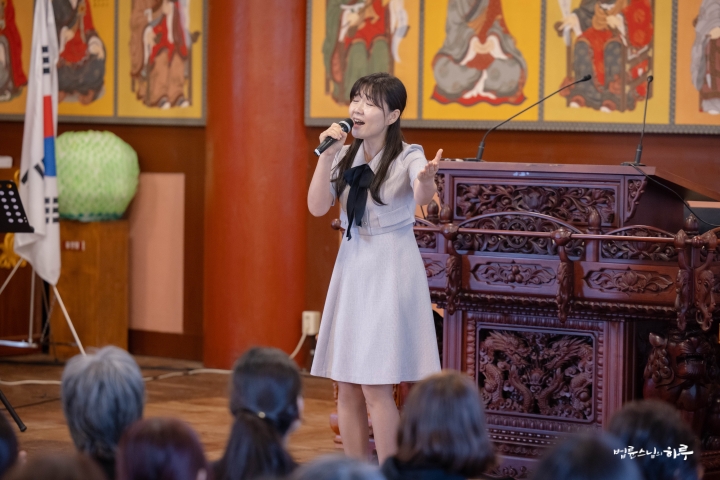
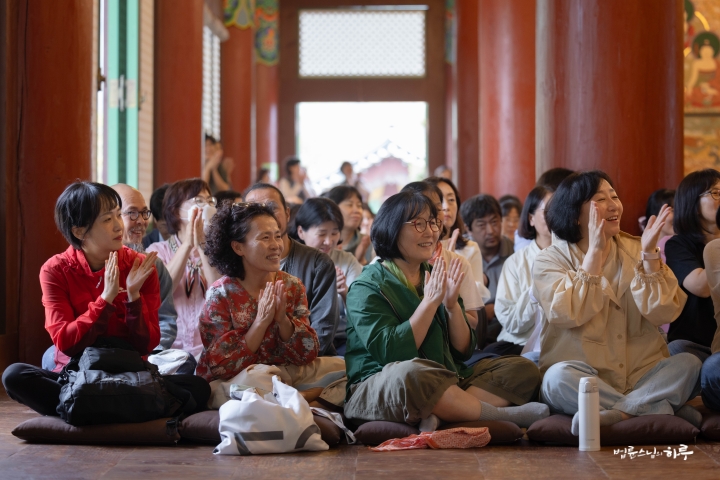
With the lingering afterglow of the performance, everyone present was given the opportunity to raise their hand and ask questions to Sunim. For about an hour, people freely asked questions about doubts that arose while practicing or doing volunteer work. One person asked for Sunim’s advice on what to do as a mother when her son, after getting divorced, found child support burdensome and asked her to pay it instead.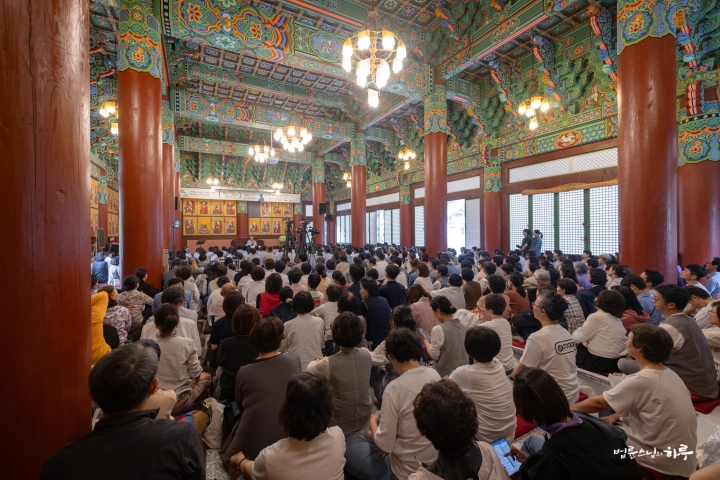
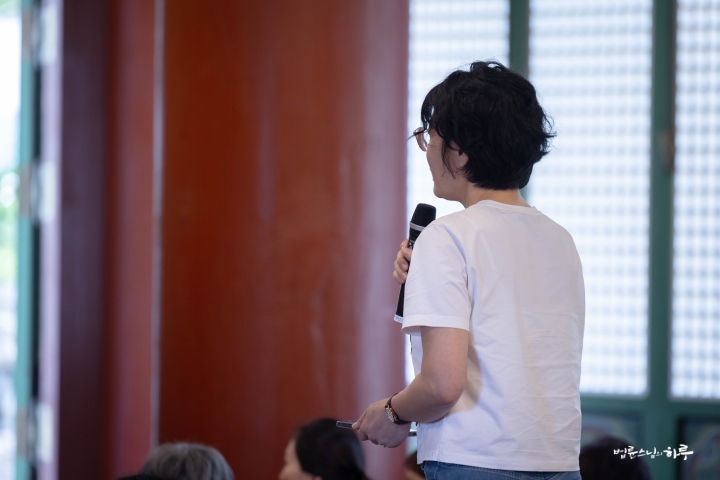
My Son Wants Me to Pay His Child Support After Divorce, Can I Refuse?
“Your son must think you have some money?”
“Actually, I don’t have money, but my son seems to be mistaken.”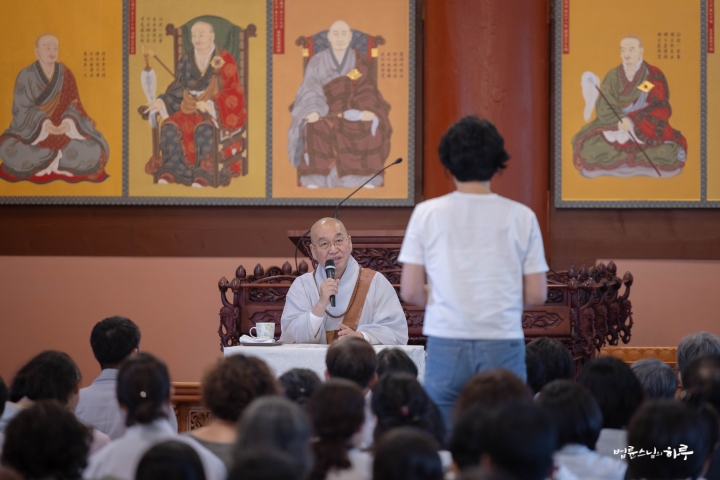
“That’s not the case. The fact that you’re having this dilemma means two things. First, your son is asking because he thinks you have money, and second, you’re feeling conflicted because you think you can actually help him to that extent. For example, if someone comes to me and says, ‘Sunim, I’m about to die. Please lend me just 10,000 won,’ I firmly say, ‘Jungto Society doesn’t lend money.’ I might still feel a slight twinge of guilt. But if someone says, ‘My company is about to go bankrupt. Please lend me 3 trillion won,’ would I feel guilty after refusing? Not at all.
This feeling of guilt arises when I can actually do something but choose not to. If I absolutely can’t do it or have no interest at all, I don’t feel guilty. Also, if someone comes and says, ‘Sunim, I need to buy drugs, please give me 100,000 won,’ I wouldn’t feel guilty at all. Whether we feel guilty or not depends on ‘what kind of matter it is’ or ‘whether I can do it or not.’
From your son’s point of view, he’s asking because he believes you’d help him — even if it meant taking out a loan. And you’re torn about whether to help because you actually have the ability to. That’s why I’m saying ‘it seems like you have some money.’ If you really don’t have money, you can honestly say, ‘I understand you’re having a hard time, but I’m also struggling to make ends meet. At my age, I can’t take out a loan to support you.’ In this case, you need to have the perspective that ‘this is your problem, not mine.’ 
However, if the situation changes—if your son dies, your daughter-in-law can’t make ends meet, and your grandchild can’t even attend school—then it would be right to help. In that case, you wouldn’t be helping because he’s your grandchild, but because he desperately needs help. Even if it were a neighbor’s child, helping would be the right thing to do. In such circumstances, drawing a line and saying it’s not your business would not be appropriate. But that’s not the current situation. Right now, this is your son’s problem, so you don’t need to get involved.
You worry about what to do if your son asks for help again, but if you don’t have money, even if he calls a hundred times, you can simply say, ‘Yes, I understand it must be really hard. But I don’t have any money.’ Even if he asks a thousand times, not just a hundred, you can respond, ‘Yes, I understand. But I can’t give you any.’ The problem arises because you keep listening to your son’s words and letting your heart waver. But the fact that you’re troubled itself means you’re in a position to help. If you really couldn’t afford to help, there would be no reason to agonize over whether to give or not. Also, even if you have the means, if you don’t think it’s right to give, then don’t. For example, it’s right not to give money if it would just go toward alcohol or drugs. 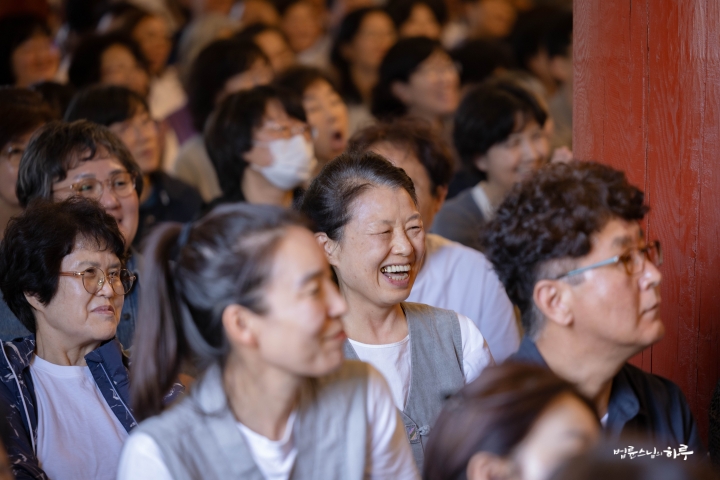
You say it weighs on your mind because it’s your son’s matter and your grandchild’s matter – that’s attachment. Ultimately, it’s your choice. You can help them thinking, ‘I can afford it,’ ‘My son is struggling, so I’ll help,’ or ‘I help others, so why not help them?’ Or, if not, whether he calls a hundred times or ten thousand times, you can simply respond, ‘Yes, I understand. But I can’t give you the money.’ There’s no need to fight. Don’t argue saying, ‘Your child is your responsibility, why are you pushing it onto me?’ Fighting about it means you’re troubled by it, and attachment has already formed. Just gently say, ‘Yes, I understand. But I can’t give it to you,’ and lightly refuse and move on. It doesn’t matter how many times he calls.
Let’s say someone has to pay 100,000 won every month, but they only have 100,000 won on hand right now. If they pay that amount, they won’t have money for other things, so they ask someone else to pay it for them. Later, when they get money, will they use it to pay back the debt or spend it elsewhere? Usually, they just spend it elsewhere. Similarly, if you give money now, you’re taking on your son’s responsibility, not actually helping him. If you don’t give him money, your son will either drink one less glass of alcohol or skip a meal. But if his mother solves it for him, he’ll drink one more glass and buy more food. That’s how people’s minds work. 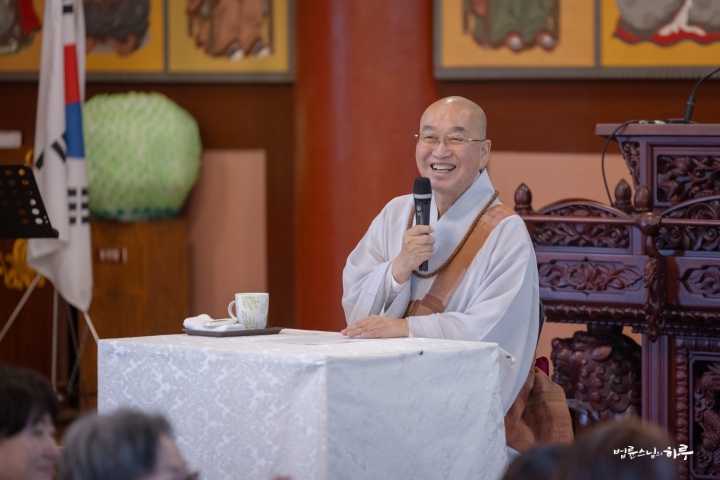
If the son doesn’t take responsibility, it will ultimately hurt the relationship between his own son and himself as a father. From the grandson’s perspective, there’s a huge difference between receiving help directly from his father versus being neglected by his father and receiving help from his grandmother instead. In such cases, how could any emotional bond develop with the father? So this is absolutely not your responsibility. If your son had passed away, you might help, but right now this is not your concern at all. It would be good to maintain this perspective.”
“Yes, I understand.”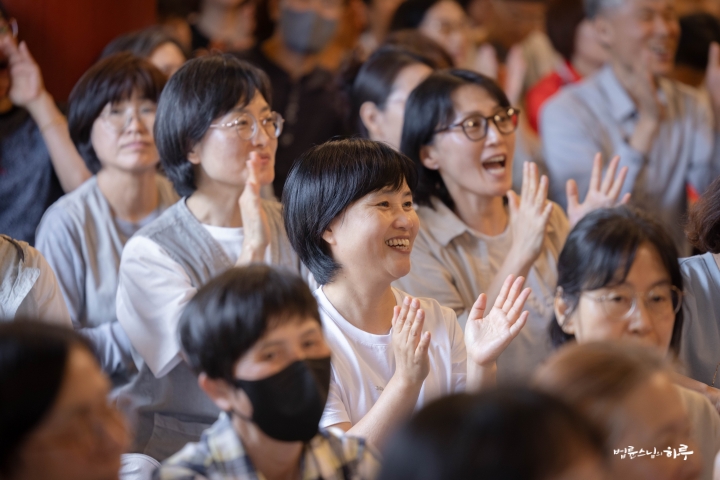
Questions continued one after another. After conversing with five people, the Dharma Q&A session concluded after 1 PM.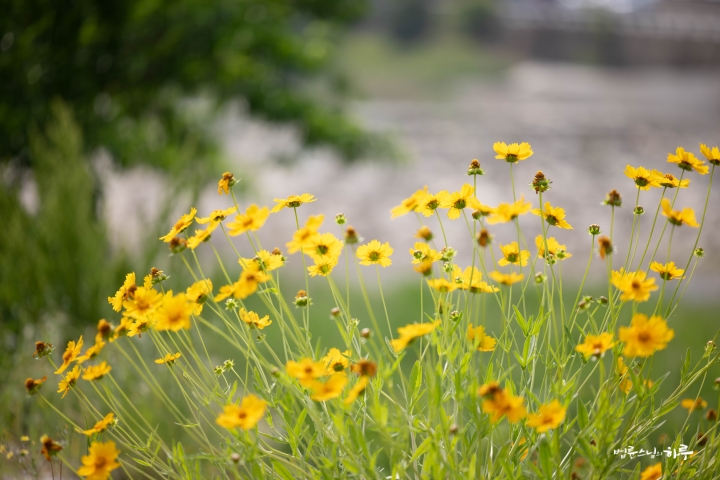
Following this, there was time for lunch. The members of the Sangha took out their packed lunches and gathered in small groups to enjoy their meals before cleaning the temple grounds.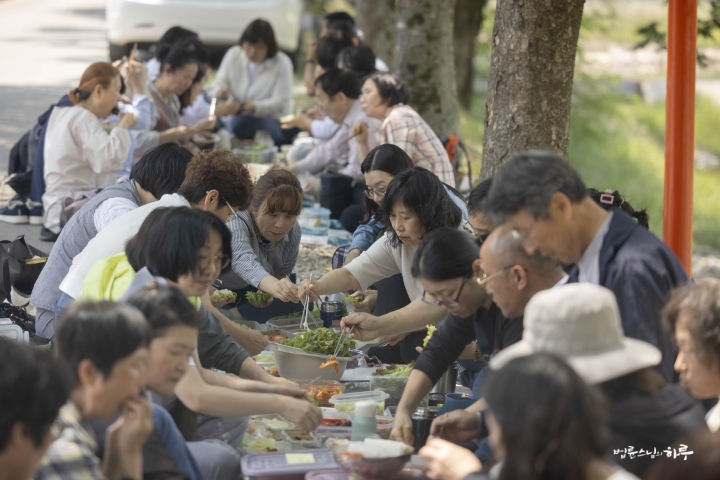
Sunim also had a simple lunch, then departed from Jangsu at 2 PM heading for Seoul.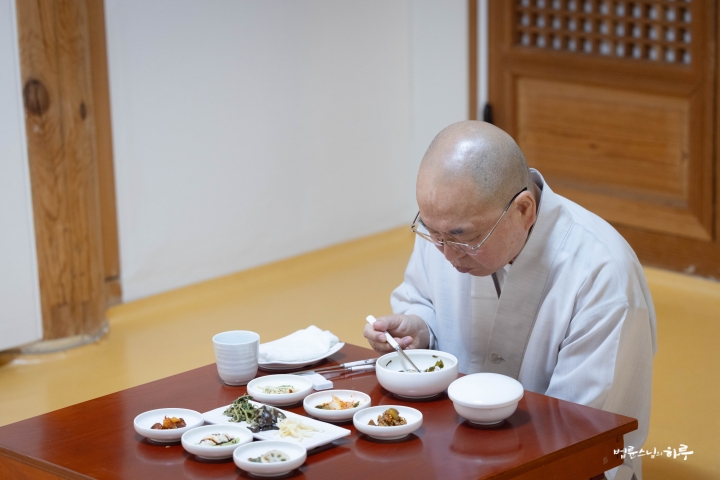
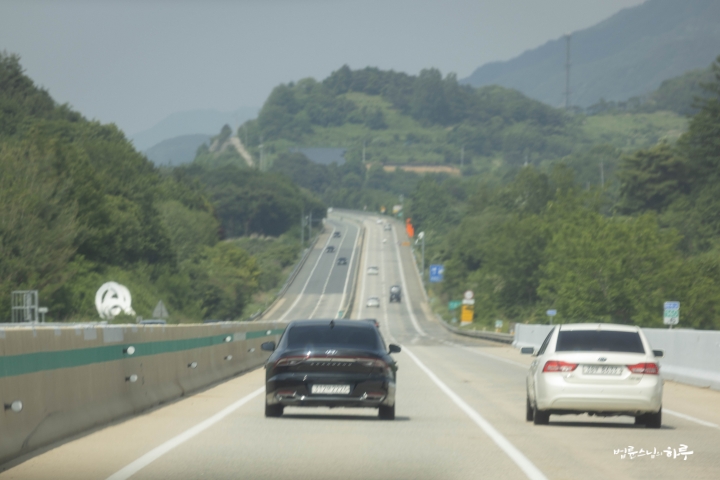
After a three-hour drive, he arrived in Seoul at 5 PM and had dinner. As the sun set, from 7:30 PM, a meeting was held at the Peace Foundation conference room with leaders from the Special Youth Division and Social Activities Committee on the topic of “Youth Dharma Propagation.”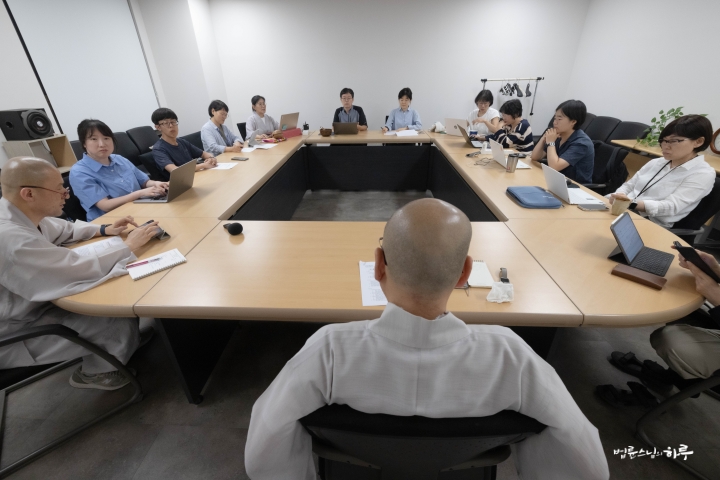
Since last year, Sunim has repeatedly suggested holding a youth festival to give hope and courage to young people who are struggling with various issues such as youth unemployment, low birth rates, housing problems, and the burden of private education costs. This was the fourth meeting held since last month to implement this plan.
After reviewing the draft prepared by the Special Youth Division and gathering opinions from various participants, Sunim gave his concluding remarks.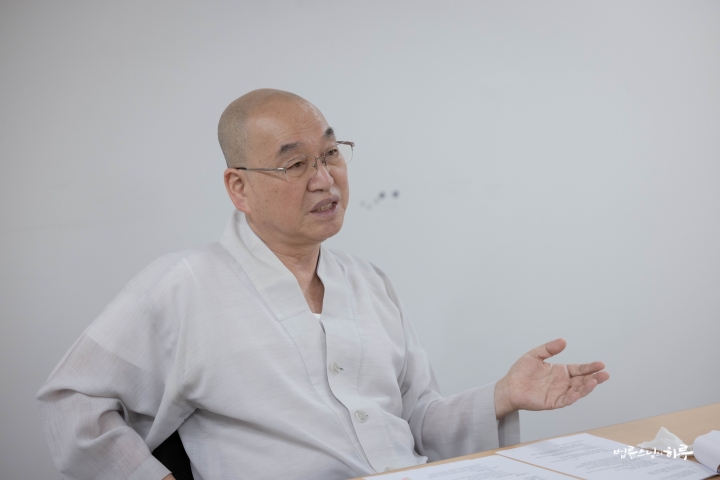
“Let’s first decide to hold a youth festival with 10,000 young participants at the Jungto Social and Cultural Center from November 7th to 9th. We’ll discuss and finalize the event name later. Since Jungto Society pursues both practice and social action together, I hope we don’t overemphasize only meditation, which young people are interested in. Even when conducting meditation programs, it’s necessary to provide specific guidance on meditation methods so participants can have proper experiences.
What Content Should We Include in a Festival for 10,000 Young People?
Among the lecture topics, I’d like to include informing young people that the Korea risk is precisely the danger of war. We also need to let young people know that inter-Korean cooperation will greatly benefit Korea’s future economy. This is because nowadays, young people can only think, ‘Isn’t cooperating with poor North Korea a loss for us?’ However, cooperation with North Korea could actually become a source of livelihood for young people. I hope we can hold lectures, even on a small scale, that inform them how combining South Korea’s technology and capital with North Korea’s labor and resources would bring tremendous benefits not only to North Korea but also to South Korea.
JTS could prepare a program introducing how young people who volunteered in India and the Philippines are living now. When I go to give lectures in various places, I often see young people who participated in the Seonjae Youth Program now playing important roles throughout society. Having those young people with volunteer experience come and share their stories could also inspire today’s youth.
Based on these considerations, I think we can gradually develop programs through continued research. Since I’ll be starting my overseas schedule tomorrow, I hope you all will continue to have more discussions going forward.”
“Yes, Sunim. Have a safe trip.”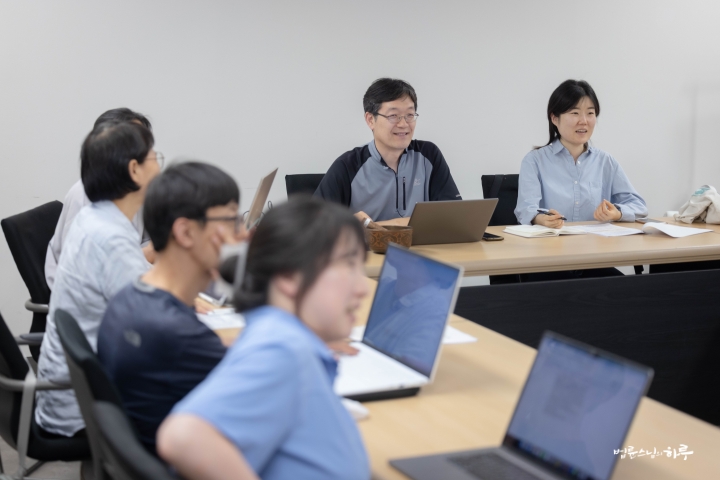
The meeting concluded after 9 PM.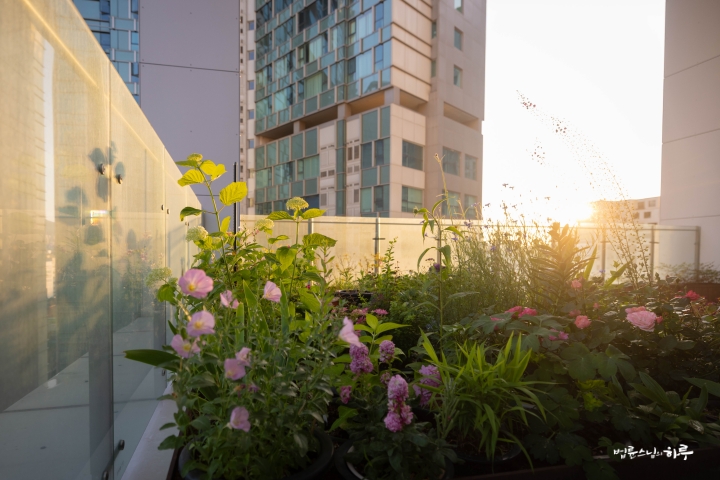
Sunim packed his luggage for tomorrow’s overseas departure and concluded his day’s activities.
Starting tomorrow, he will visit Laos for three days and two nights to review JTS projects and meet with local officials.
